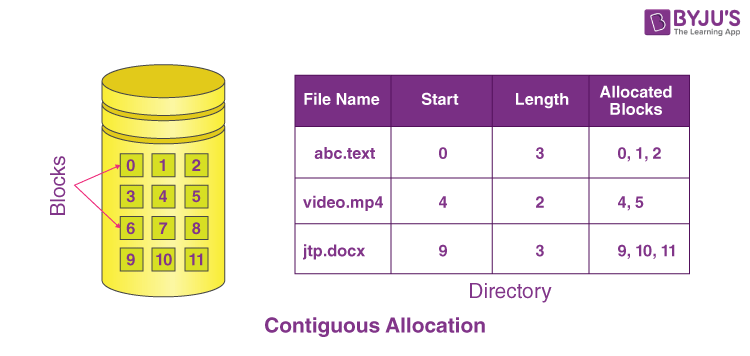When the blocks are allocated to a file in such a manner that every logical block of the file gets a contiguous physical block in the hard disk, then this allocation scheme would be known as a contiguous allocation.
In this article, we will look more into the Contiguous Memory Allocation in Operating Systems according to the GATE Syllabus for (Computer Science Engineering) CSE. We will read ahead to find out more about it.
Table of Contents
- What is Contiguous Memory Allocation in Operating Systems?
- Types of Partitions
- Pros of Contiguous Memory Allocation
- Cons of Contiguous Memory Allocation
What is Contiguous Memory Allocation in Operating Systems?
Contiguous memory allocation refers to a memory management technique in which whenever there occurs a request by a user process for the memory, one of the sections of the contiguous memory block would be given to that process, in accordance with its requirement.

As you can see in the illustration shown above, three files are there in the directory. The starting block, along with the length of each file, is mentioned in the table. Thus, we can see in this table that all the contiguous blocks get assigned to every file as per their need.
Types of Partitions
Contiguous memory allocation can be achieved when we divide the memory into the following types of partitions:
1. Fixed-Sized Partitions
Another name for this is static partitioning. In this case, the system gets divided into multiple fixed-sized partitions. In this type of scheme, every partition may consist of exactly one process. This very process limits the extent at which multiprogramming would occur, since the total number of partitions decides the total number of processes. Read more on fixed-sized partitions here.
2. Variable-Sized Partitions
Dynamic partitioning is another name for this. The scheme allocation in this type of partition is done dynamically. Here, the size of every partition isn’t declared initially. Only once we know the process size, will we know the size of the partitions. But in this case, the size of the process and the partition is equal; thus, it helps in preventing internal fragmentation.
On the other hand, when a process is smaller than its partition, some size of the partition gets wasted (internal fragmentation). It occurs in static partitioning, and dynamic partitioning solves this issue. Read more on dynamic partitions here.
Pros of Contiguous Memory Allocation
1. It supports a user’s random access to files.
2. The user gets excellent read performance.
3. It is fairly simple to implement.
Cons of Contiguous Memory Allocation
1. Having a file grow might be somewhat difficult.
2. The disk may become fragmented.
Keep learning and stay tuned to get the latest updates on GATE Exam along with GATE Eligibility Criteria, GATE 2023, GATE Admit Card, GATE Syllabus, GATE Previous Year Question Paper, and more.
Also Explore,
- Batch Operating System
- Binary Semaphores in Operating System
- Counting Semaphores in Operating System
- Deadlock Detection and Recovery in Operating System
- Deadlock Prevention in Operating System
- Distributed Operating System
- Dynamic Partitioning in Operating System
- Fixed Partitioning in Operating System
- Functions of Operating System
- Operating System GATE Questions
- Methods for Handling Deadlock in Operating System
- Multiprocessing Operating System
- Multiprogramming Operating System
- Multitasking Operating System
- Network Operating System
- Non-Contiguous Memory Allocation in Operating System
- Operating System Services
- Paging in OS
- Process in Operating System
- Process Scheduler in Operating System
- Process Scheduling in Operating System
- Process State in Operating System
- Real-Time Operating System
- Resource Allocation Graph in Operating System
- Semaphores in Operating System
- Time-Sharing Operating System
- Types of Operating System